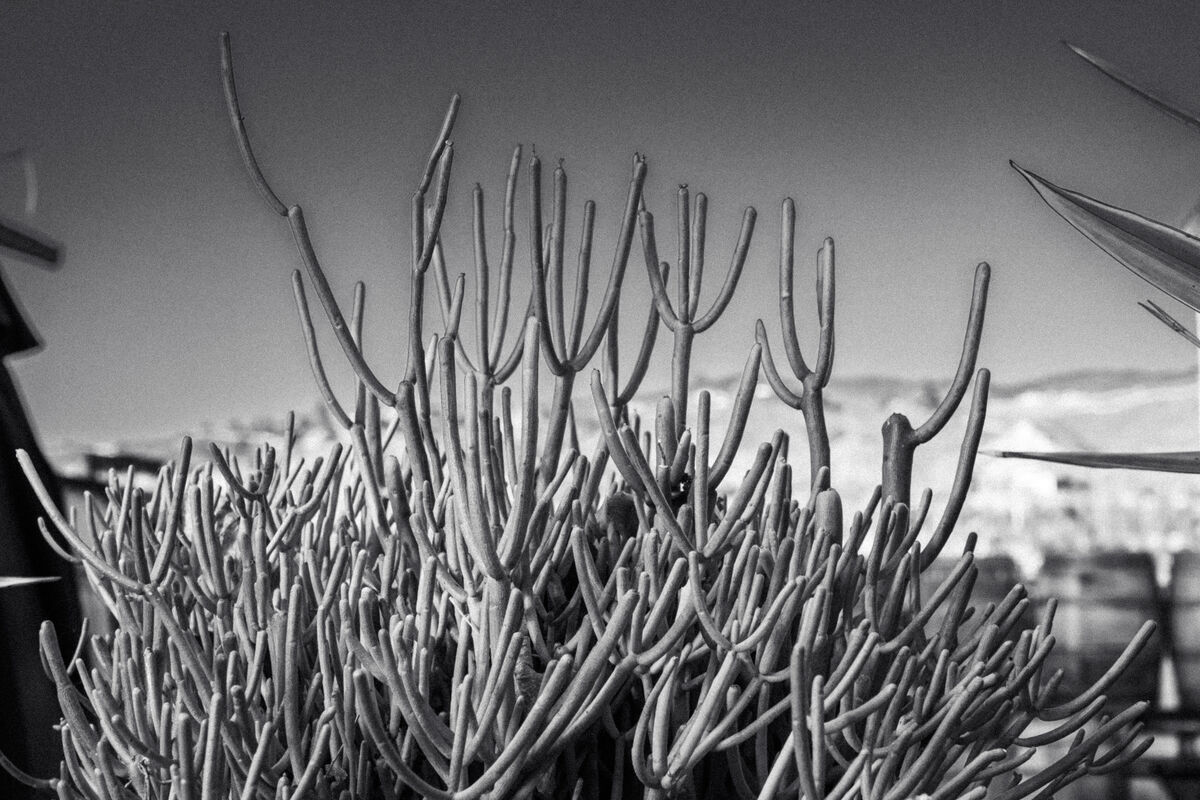Posts for: burkphoto
Apr 23, 2024 12:26:23 #
Resurrecting dead threads by commenting on them is not recommended. If it has been more than a month since a thread was active, then chances are, the issue in the topic has been resolved, the dead horse has been flogged at least once, and the carcass sent to the glue factory.
This thread is over THREE YEARS OLD. I'm certain that the original poster has long since made a decision and moved on.
Kindly refrain from using the term, "mirrorless DSLR," referred to in the title. There is no such thing as an SLR or dSLR without a mirror. There would be no "Reflex" without a mirror.
The intended term is Digital MILC. MILC stands for mirrorless interchangeable lens camera. (Film MILCs (for example, the Leica M6) are known as rangefinder cameras).
This thread is over THREE YEARS OLD. I'm certain that the original poster has long since made a decision and moved on.
Kindly refrain from using the term, "mirrorless DSLR," referred to in the title. There is no such thing as an SLR or dSLR without a mirror. There would be no "Reflex" without a mirror.
The intended term is Digital MILC. MILC stands for mirrorless interchangeable lens camera. (Film MILCs (for example, the Leica M6) are known as rangefinder cameras).
Apr 22, 2024 22:10:22 #
User ID wrote:
Acoarst I knew someone was bound to cite that "magic moment" in the print tray. And acoarst I experienced that magic. The only thing since then that smacks me as equally magical is digital image capture. Polaroid is nothing next to the magic of digital (and I used Polaroid up thru 8x10). Not denying Polaroid (BW) was huuugely magical to me around 1962 !!!
Magic ? Without even a sound, I can burst 75fps, all perfect, and visible immediately. Now THAT is magic !
Magic ? Without even a sound, I can burst 75fps, all perfect, and visible immediately. Now THAT is magic !


Apr 22, 2024 19:51:30 #
TriX wrote:
As long as we’re discussing film, has anyone tried the CineStill 2 bath C-41 color negative processing chemicals? I’ve usually used the 4-5 chemical process, but this is getting excellent reviews and the pricing is very reasonable.
https://cinestillfilm.com/products/cs41-simplified-color-processing-at-home-quart-kit-c-41-chemistry?variant=30376678593
https://cinestillfilm.com/products/cs41-simplified-color-processing-at-home-quart-kit-c-41-chemistry?variant=30376678593
Look for YouTube reviews of it. I remember watching a couple of them.
Apr 22, 2024 13:04:36 #
radiojohn wrote:
I was cleaning out a closet and found some CDs wit... (show quote)
I have over 100 CDs I burned from 2000 to 2017. I haven't had any of them fail. They were all burned in an Apple Superdrive, on name brand CD–R blanks. Most are stored in paper sleeves at room temperature.
That said, I'm under no illusion they will last 100 years, or that they will be readable on available systems then. I do believe that SOMEONE will have systems to read archives made on media from the past.
That said, when I'm dead and gone, I won't care. I seriously doubt my kids will care, either.
I do still have thousands of negatives from the 1960s through 2005, most of which are printable or scannable in some way. The B&W ones are going to last another 50 years or more, if kept the way I've kept them. The color negs will fade, albeit far more slowly than the original sets of prints made with them.
Apr 22, 2024 12:05:58 #
Blenheim Orange wrote:
…Whether or not you use film is there value in slowing down and welcoming "happy accidents?"
Is there value in slowing down? Yes. Digital technology has been approached far too often with a "Ready? FIRE!!! Uh, aim? WTF is 'aim'? mentality."

But is using film a solution? If you think it is, then it is for you.
I used film for 45 years. It worked fine. It was all we had. But because I navigated various career opportunities to running the digital side of a very large school portrait lab around 2000, I found parallel replacements to EVERY aspect of film photography I thought I might miss or need.
I was lucky to have the professional learning opportunities of Kodak Professional seminars, Digital Imaging Marketing Association seminars, and Photo Marketing Association International seminars from 1995 to 2010. The film world shrank as the digital world exploded, for all the right reasons. The perspective I gained in the lab and from training photographers to use digital capture instead of film capture has been very gratifying.
I still work with OLD film, by copying it to digital files. But I'll probably never see the inside of a darkroom again. I have zero interest in what, for me, is drudgery.
On the other hand, all the knowledge I gained from decades of film use transferred to digital photography just fine. I get what I want with much finer control, and more quickly, than with film. The advantages of digital bits over chemical atoms for practical imaging applications are far more numerous. The biggest one is that if you have a print, you can show it off in one place at a time, but if you digitize that image, it can be "everywhere all at once," with very little effort. And if you understand the nuances of digital printing, you can make excellent prints on a myriad of papers and other substrates.
If you value slowing down, deliberating, controlling, and thinking about what you're doing, you can train yourself to ignore all or some of the automation that you find on your digital camera. Spend more time planning, lighting, and composing the scenes you're photographing. All the same basic controls are there, just as they were half a century ago. They're just easier to use.
Apr 21, 2024 20:51:00 #
Linda From Maine wrote:
Many thanks to all. I'm delighted by your responses! Do you see that the white llama (alpaca?) has a bit of weed in her mouth? She seemed to be enjoying playing with it.
There was also a billy goat. If I had shared a pic him too, I would have titled the topic "Two Llamas and a Goat, no Joke"
There was also a billy goat. If I had shared a pic him too, I would have titled the topic "Two Llamas and a Goat, no Joke"

Good one! (on both counts)
Apr 21, 2024 15:29:34 #
jerryc41 wrote:
Yes! DaVinci Resolve. I just watched a video showing how to sync soundtracks. Put them both on the screen and click. DaVinci does the rest. It can do only two at a time, but after syncing the first pair, you keep going and adding more. And I thought my videos were like Titanic - unsyncable. 🤣
Yep. Most advanced editing software has that feature.
Apr 20, 2024 09:00:52 #
hdfilmnoir wrote:
Is printing to metal a good choice for wildlife? b... (show quote)
Metal is an ultra flat, smooth surface with special reflective properties affected greatly by the coating surface applied to it. I generally like it for very brightly colored subjects, and choose high gloss for those. I'd rather print softer images on "rag" papers (those with high cotton fiber content).
I do like the "floating" back effect for metal. If you order it without a frame, rounded corners are a smart choice. Display metal prints where they cannot become lethal weapons by falling on someone. A heavy, large metal print cuts like a guillotine blade if it falls on someone.
Apr 18, 2024 12:10:32 #
R.G. wrote:
Optical filters remove things. The sliders in you... (show quote)


Masking tools in LrC help, too.
Apr 18, 2024 11:17:13 #
nikon123 wrote:
I want to add more 'pop' to my blsack & white photographs. The processing program that I use has the sliders for the various colours but once employed they do not impact the images greatly or should I say sufficiently. Would I be better served by purchasing a set of colour filters?
Thank you in advanc e for your consideration of this topic and any responses that you can offer.
Thank you in advanc e for your consideration of this topic and any responses that you can offer.
Much depends upon the sophistication of your post-processing program. All the controls can be used. As a general rule, I use whatever approach gives me the result I like, and don't worry much about the structure of it. HOWEVER,
I like to start with an accurate color development of my image. Then I play.
Here's one that took just a few minutes. It's not particularly stunning, but I like the mood of both color and B&W.
The only filters I have in my bag today are various Neutral Density (-3, -6, and -10 stop densities), circular polarizers, and clear glass protectors. I have a box in the closet with over 80 filters from my film days. Digital tools are too good to bother with them.
Apr 17, 2024 21:32:07 #
gener202002 wrote:
In Spanish for the most part a vowel is pronounced... (show quote)
Yep. I took Latin in junior high for two years. I can usually decipher signs in Mexico when they are in Spanish only, but I don't speak Spanish. French is also mostly Latin, but farther from it than Spanish.
Apr 17, 2024 12:18:37 #
TriX wrote:
Agreed. I’m now reading The NY Times and the Washington Post.
Same here. The Charlotte Observer has a good online presence as well.
Apr 17, 2024 11:32:39 #
TriX wrote:
That and Doonsbury… I started every day with the Raleigh News and Observer for almost 40 years, but it just became a shell of its former self. The editorials were gone, the “main section” dropped to 8 pages, stopped printing the obits and the delivery became sporadic (farmed out to a 3rd party) along with offshore billing management run by crooks. RIP N&O - a sadness.
Newspapers by and large were unable to see beyond their paradigm. They were given the new model by Apple. Only a handful took it and ran with it successfully.
Apr 17, 2024 11:26:19 #
charles tabb wrote:
As I remember from school the vowels were a e i o u and sometimes y
Sorry ! I don't have an example for the Y.
I'm getting too old now, I guess.
Sorry ! I don't have an example for the Y.
I'm getting too old now, I guess.
Same letters; different sounds in different languages... even different sounds in regional versions of English (American vs British)
Apr 17, 2024 10:19:37 #
SteveR wrote:
Burk...Consider the richness and variation of two things before mass communication in America: accents and music.
I would argue that both are still with us, although accents may be weaker due to broadcasters' influences, and music may be MUCH more highly evolved due to recording and transmission technologies.
America is a huge melting pot of cultures. The more populous the state, the more likely it is full of different influences from all over the world.

